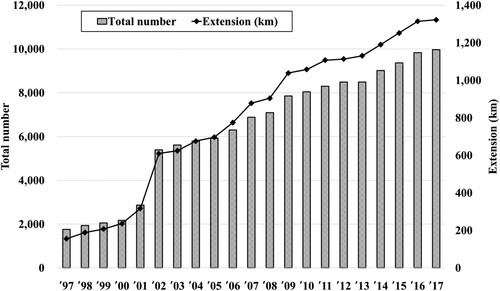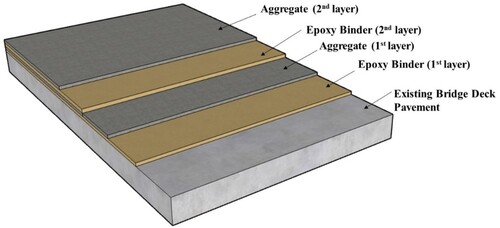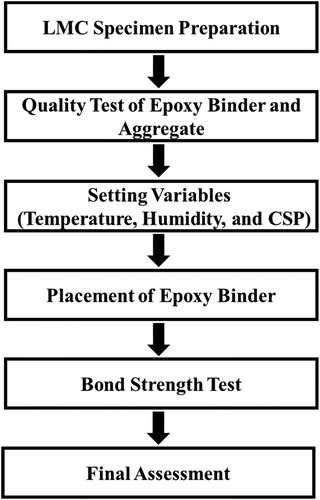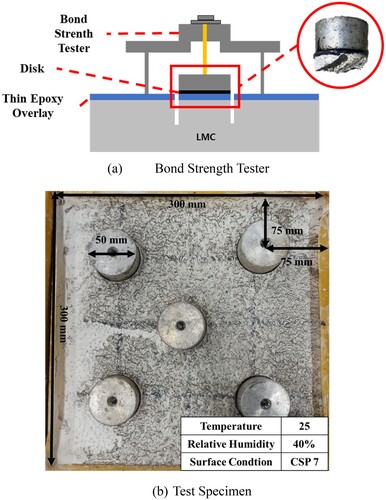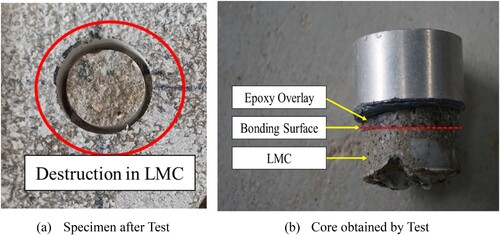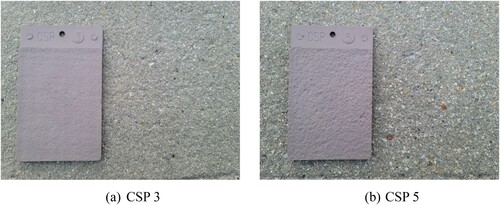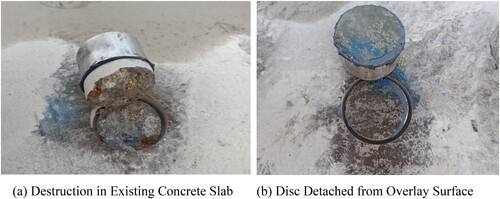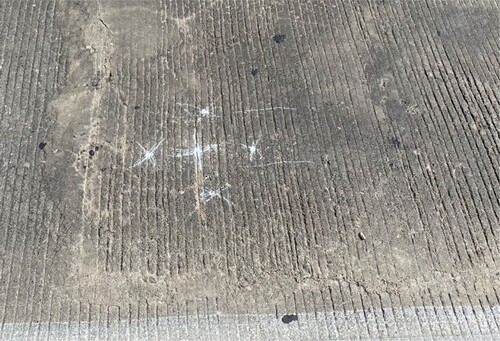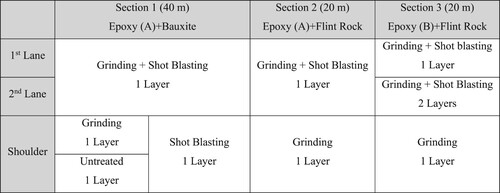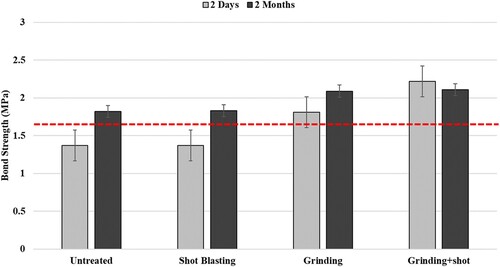ABSTRACT
This study investigated the factors influencing the bond strength between existing pavement and thin epoxy overlay via laboratory and field tests. Laboratory tests revealed that the highest bond strength occurred at a general temperature and relative humidity of 25 °C and 60%, respectively. The concrete surface profile (CSP) of the specimen was found to have no impact on the bond strength between the latex-modified concrete (LMC) and epoxy binder under favorable conditions. Field testing of well-maintained concrete pavements indicated that neither the existing pavement's pre-treatment process nor its resulting CSP affected the bond strength. However, the bond strength decreased with environmental and vehicle loadings six months after the overlay. A second field test conducted on a deteriorated bridge deck with an LMC pavement revealed that most of the damage occurred at a shallow depth in the existing pavement, demonstrating low bond strength just two days after construction owing to inadequate removal of the deteriorated section. The initially low bond strength increased over time as the epoxy binder permeated the deteriorated area and hardened at greater depths, thus making it necessary to thoroughly remove all deteriorated sections of the existing pavement before constructing a thin epoxy overlay.
1. Introduction
Since the late 1990s, latex-modified concrete (LMC) has been extensively utilised as the primary material for bridge deck pavements on Korean expressways. The span of bridge decks paved with LMC has increased substantially from 155 km in 1997 to 1322 km in 2017, comprising approximately 75% of the total bridge deck pavements, as depicted in (MOLIT Citation2019). The service life of an LMC bridge-deck pavement is estimated to be approximately 20–25 years (Lee et al. Citation2006, Kim et al, Citation2016). Consequently, the late 2010s have seen a significant increase in the demand for repairs or extensive refurbishments of LMC bridge deck pavements initially constructed in the late 1990s. Moreover, given the considerable cost and time required to repave or extensively repair using existing materials (AASHTO Citation1995), new repair materials have been introduced as alternatives to LMC or conventional concrete.
In numerous states across the United States of America (USA), thin overlays are commonly utilised to construct new or repair deteriorated pavements (Justin et al, Citation2016). This overlay involves the utilisation of a binder that mixes epoxy (a polymer and its main ingredient) with a hardener (additive) (Kim et al. Citation2013). Thin epoxy overlay techniques can be categorised into three types according to the construction method: broom and seed, slurry, and premixed methods (Choi et al, Citation2021). Among these, the broom and seed method (i.e. the multilayered thin overlay method) is the most widely employed in the USA. This method thinly spreads the epoxy binder over the existing pavement, with fine aggregates dispersed over the epoxy binder, as illustrated in . Typically, two layers greater than 12 mm in thickness were paved. If this minimum thickness is not achieved, the American Concrete Institute (ACI) recommends the addition of an additional layer (ACI Citation2014). As a result, basic material properties and field applicability of thin epoxy overlays have been extensively studied (Kim Citation2014).
Before constructing a thin epoxy overlay, the surface of an existing pavement with severe distress, such as cracks, requires pre-treatment via milling or partial depth repair. However, overlay construction can proceed without pre-treatment for existing pavements with only minor cracks because the epoxy binder acts as a sealing material for minor distress. Constructing a thin epoxy overlay pavement can be completed and reopened to traffic within four hours (Kim Citation2014).
Epoxy is a high molecular-weight substance that exhibits significant resistance to fire, water, and chloride (Kim Citation2014). Despite these benefits, the overlay can be separated from the existing pavement if the epoxy quality is poor or the construction method is unsuitable (ACI, Citation2019 ACI). Therefore, the potential distress that may occur during the service life of a thin epoxy overlay pavement can be assessed by testing the bond strength between the overlay and the existing pavement.
Bond strength can fluctuate based on various factors, such as temperature, humidity, overlay age, traffic load, and the pre-treatment method employed for the existing pavement surface. The characteristics of the hardener blended with the epoxy binder are temperature-dependent, affecting the epoxy binder’s curing speed and performance (ACI Citation2016). The formation rate of capillary pores in the epoxy binder during curing is also influenced by humidity, which affects curing speed and performance (Réquilé et al. Citation2019). Hence, the construction and curing of thin epoxy overlays must be performed under suitable temperature and humidity conditions. Moreover, a rough surface on an existing pavement can enhance the bond strength by increasing the bonding area (ACI Citation2014). Consequently, depending on the pre-treatment method, the condition of the existing pavement surface can influence the durability of thin epoxy overlay pavements.
Therefore, the factors influencing the bond strength between the existing pavement and thin epoxy overlay were investigated by performing laboratory and field tests under various conditions, such as the concrete surface profile (CSP) of the existing pavement, degree of removal of the deteriorated part on the existing pavement surface, curing period of the epoxy binder, temperature, humidity, and repetitive traffic loading. This study investigated the factors influencing the bond strength between the existing pavement and epoxy overlay to improve the performance of thin epoxy overlay pavement by controlling the influencing factors.
2. Laboratory test for LMC specimens in good condition
The bond strength is subject to variation based on the pre-treatment method, as the bonded area between the existing pavement surface and the epoxy binder can change depending on the chosen method. Moreover, the bond strength can fluctuate according to climatic conditions because the properties of the epoxy binder are influenced by temperature and humidity. Therefore, laboratory tests here were conducted on the bond strength, considering the CSP of the LMC surface, temperature, and humidity conditions. illustrates the laboratory test procedure.
2.1. Preparation and testing process of bond strength specimens
An LMC specimen measuring 300 × 300 × 50 mm was cured at 25 °C and 60% relative humidity for 28 days. Subsequently, the surface of the LMC specimen bonded to the epoxy binder was pre-treated. The pre-treatment results were categorised into Steps 1–10 according to the CSP – an evaluation standard proposed by the International Concrete Repair Institute, Inc. (ICRI) (ICRI Citation2013). For the surface of an existing pavement to be overlaid with polymer concrete, the ACI recommends pre-treatment to exceed a CSP of 5 (ACI Citation2016). The ICRI provided guidelines for the diameters of shot balls to be utilised for shot blasting equipment and noted that the CSP varies based on the performance of the shot blasting equipment and the speed and number of pre-treatment operations. This study realised CSP 3, 5, and 7 for the LMC specimens, as listed in , by applying varying numbers of shot-blasting operations utilising a single type of shot ball (Sun Z., Citation2004).
Table 1. CSP with respect to Condition of Specimen Surface.
The specimens were fabricated by applying an epoxy binder to pre-treated LMC specimens and dispersing fine aggregates onto the epoxy binder to form a two-layer overlay with a thickness of 12 mm. The epoxy binder utilised here was classified by Manufacturing Company A as Type III, Grade 2, and Class B, as regulated in ASTM C 881. The viscosity, working time, and thermal compatibility of the epoxy binder were tested to determine whether the type and grade provided by the manufacturer were correct. Consequently, the type and grade of the epoxy binders were verified by passing standards.
The fine aggregates, derived from a flint rock and spread on the epoxy binder, satisfied the specific gravity and absorption coefficient criteria (as presented in ), in addition to the gradation (#8, 600–4.75 mm) (ACI Citation2016).
Table 2. Properties of Aggregate (ACI Citation2016).
The bond strength between the existing pavement and the thin epoxy overlay can fluctuate based on temperature and humidity. Consequently, bond strength tests were conducted according to KS F 2386 standards after curing the specimens at temperatures of – 10, 25, and 40 °C, each at 60% relative humidity. In addition, they were cured under conditions of complete dryness, 40%, 60%, 80%, and complete wetness of varying relative humidity, each at a constant temperature of 25 °C, for 7 days.
The circular core drill penetrated approximately 30 mm deep and was removed at five locations on the surface of each specimen, as illustrated in . Circular discs attached to the overlay surface were extracted to measure the maximum tensile force immediately before the specimen failure. If the bonding interface between the epoxy binder and the LMC became unbonded or the existing pavement was damaged (as illustrated in ), the maximum tensile force divided by the circular area was the bond strength. However, if the disc detached from the overlay surface, the test was classified as a failure.
2.2. Results of laboratory bond strength test
Owing to the laboratory tests, comparable bond strengths of 2.49, 2.62, 2.54, and 2.57 MPa were measured for the specimens pre-treated under the untreated, CSP 3, CSP 5, and CSP 7 conditions, respectively, as depicted in (a). All bond strengths satisfied the 1.7-MPa criterion suggested by the ACI. The specimen pre-treated with CSP 3 demonstrated the highest bond strength despite its CSP being lower than those pre-treated with CSP 5 and 7. Therefore, the CSP of the specimen did not significantly affect the bond strength between the LMC and epoxy binder.
Figure 6. Laboratory Bond Strength Utilising CSP. (a) Distribution of Bond Strength; (b) Percentage of Destruction Location.
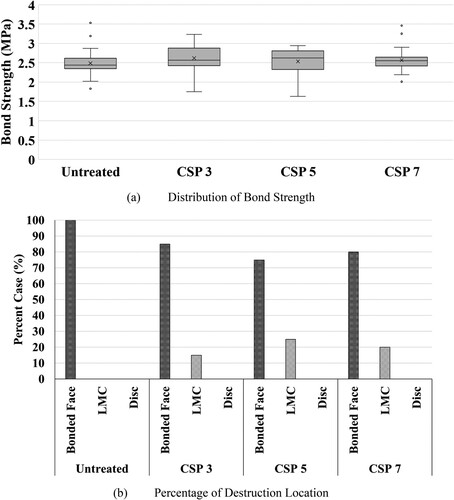
In approximately 65% of the specimens, the bonding interface between the epoxy binder and the LMC became unbonded, as illustrated in (b), whereas approximately 20% experienced LMC destruction. Furthermore, less than 10% of the specimens failed the test because the disc adhering to the overlay surface detached owing to the tensile force. Consequently, the bond strength between the LMC and epoxy binder can be precisely verified because most instances of debonding occur at the bonding interface. However, in some cases, if the LMC is destroyed before debonding at the bonded interface, the bond strength cannot be precisely verified because the strength at the bonding interface exceeds that of the LMC.
The bond strengths relative to the humidity and temperature are depicted in . The specimens cured under completely wet conditions exhibited bond strengths of approximately 1.3 MPa, failing to satisfy the 1.7-MPa criterion suggested by the ACI, as illustrated in (a). However, the specimens cured under arid conditions at 40–60% and 80% relative humidity satisfied this criterion. Notably, the specimen cured at 60% relative humidity exhibited the highest bond strength of approximately 2.7 MPa. The bond strength is reduced in completely wet conditions due to the formation of gaps between the LMC and epoxy binder, high molecular-weight substances that cannot combine with moisture (Réquilé et al. Citation2019). However, the bond strength of the specimens cured under arid conditions was higher than those cured under completely wet conditions because the strength was bolstered by forming capillary pores, which facilitated moisture transport within the epoxy binder, even under arid conditions.
Figure 7. Laboratory Bond Strength with respect to Relative Humidity and Temperature. (a) Bond Strength with respect to Relative Humidity; (b) Bond Strength with respect to Temperature.
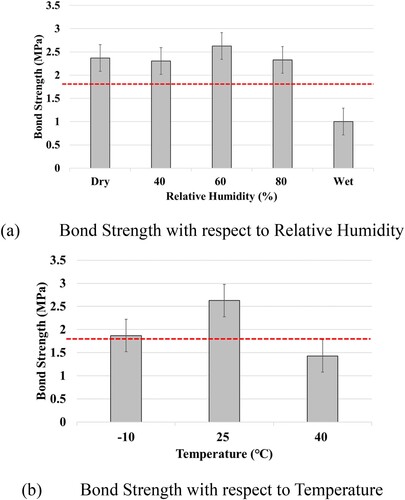
As depicted in (b), specimens cured at temperatures of – 10 and 25 °C exhibit bond strengths of 1.87 and 2.62 MPa, respectively, fulfilling the ACI criterion. However, the bond strength of the specimen cured at a temperature of 40 °C was only 1.43 MPa, failing to satisfy the criterion. A substantial decrease in the bond strength was observed at higher temperatures owing to alterations in the properties of the hardener, a type of polyamine, in response to temperature changes. Although temperature and humidity influence the bond strength, temperature control takes precedence over humidity control during construction because temperature variations significantly affect the rate of change in the bond strength.
3. Field test for existing concrete pavement in good condition
The experiment was conducted in Samcheok, Gangwon, Korea. A thin epoxy binder and fine aggregates were overlaid on an existing concrete pavement with a width of 3.4 m and length of 30 m. Concrete pavements were temporarily employed during the construction of the Donghae Expressway (Route No. 65) but have remained unused since the expressway opened to traffic in 2016. A visual survey conducted immediately before experimental construction revealed no distress, including cracks (Kim et al, Citation2019).
The entire 30-m field test section was divided into six subsections of varying lengths (2, 6, and 12 m) based on the pre-treatment method and overlay step, as depicted in . Consistent with the laboratory tests, an epoxy binder produced by Company A (Type III, Grade 2, Class B) and fine aggregates crafted from flint rock (#8, 600, 4.75 mm) were utilised as overlay materials (ACI Citation2016, ASTM Citation2018). Bond strength tests were conducted immediately, 6 months, and 1 year following experimental construction to verify the variation in the durability of the thin epoxy overlay pavement based on the CSP, overlay age, and repetitive traffic loading.
3.1. Construction and test methods
No rainfall occurred during construction, while the average ambient temperature ranged between 13–15 °C, satisfying the ACI’s criterion of a minimum of 10 °C. The ambient relative humidity at the commencement of the experimental construction was approximately 40% and gradually decreased to 20–30%, where it remained until the end of the construction process. The surface of the existing pavement slab was pre-treated with a shot blaster, as illustrated in (a). As recommended by the ICRI, CSPs 3 and 5 were simulated on an existing pavement surface by utilising a specific type of shot ball and varying numbers of shot blasts. The CSP of the existing pavement after pre-treatment was determined by comparing its roughness with that of the CSP samples provided by the ICRI, as illustrated in . The binder, comprising a blend of three parts epoxy and one part hardener, was manually applied to the pre-treated existing slab surface, as depicted in (b). Subsequently, the aggregates were spread over the epoxy binder to complete the first layer with a 6–7 mm thickness. Four hours after completing the first layer, the second layer was overlaid employing the same method. Hence, a two-layer overlay with a total thickness of 12–13 mm was realised, as presented in (c).
Figure 10. Paving and Testing. (a) Shot Blasting; (b) Paving; (c) Curing; (d) Truck Loading; (e) Wheel Path after Loading; (f) Bond Strength Test.
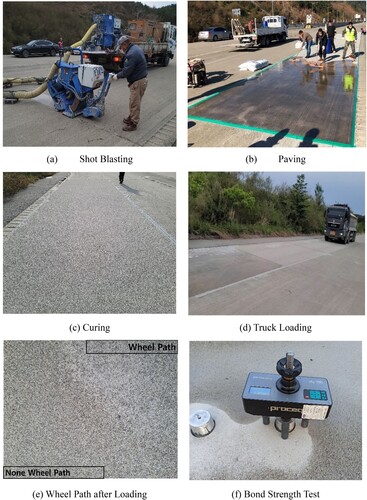
The bond strength between the well-maintained existing concrete pavement and thin epoxy overlay was tested at three different time points: 3 days, 6 months, and 1 year post-overlay, particularly focusing on the bond strengths tested immediately before and after the application of repetitive vehicular loading 6 months after the overlay to examine the influence of traffic load on the alteration of bond strength. A truck weighing approximately 40 t was utilised to simulate repetitive traffic loading by completing 600 return trips at 6 and 4 km/h, respectively, as illustrated in (d). The bond strength is tested, as depicted in (f), utilising the same method executed in the laboratory.
3.2. Results of bond strength test
According to the test results, all bond strengths satisfied the ACI criterion of 1.7 MPa, irrespective of factors such as the overlay age and traffic load, as demonstrated in . The average bond strength measured 3 days post-overlay at the site where no traffic load was applied, was 2.96 MPa, which significantly decreased to 2.58 MPa after 6 months, as indicated in (a). The reduced bond strength observed at 6 months remained similar until 1 year after the overlay, i.e. 2.52 MPa. As the overlay was applied in November, low temperatures during the first winter influenced the decrease in the early bond strength. Subsequent post-winter weather conditions did not appear to affect the bond strength.
Figure 11. Bond Strength According to Age of Overlay and Repetitive Vehicle Loadings. (a) Bond Strength with respect to Age of Overlay; (b) Bond Strength before and after Repetitive Vehicle Loadings.
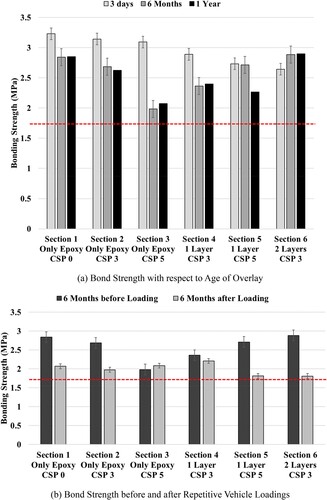
In Sections 1, 2, and 3, where only one layer of the epoxy binder was applied without dispersing the aggregates, the bond strength decreased with increasing CSP. In addition, the bond strength decreased with the age of the overlay. Section 3, which had the highest CSP, exhibited the lowest bond strength among the three sections 3 days post-overlay. This bond strength significantly dropped 6 months post-overlay, registering the lowest among all six sections.
In the case of Sections 4 and 5, overlaid with one layer of epoxy binder and aggregates, the bond strength of Section 5 (CSP 5) was lower than that of Section 4 (CSP 3) at 3 days post-overlay. Conversely, Section 6, where two layers of epoxy binder and aggregates were overlaid, demonstrated the lowest bond strength among all sections 3 days post-overlay. However, this initially low bond strength consistently increased with the age of the overlay, resulting in the highest bond strength among all sections at 6 months and 1-year post-overlay. In contrast, the bond strengths in the other sections decreased over time.
The average bond strength, initially measured at 2.58 MPa immediately before vehicle loading, decreased significantly 6 months post-overlay to 1.99 MPa immediately after repetitive loading, as illustrated in (b). Moreover, all the sections demonstrated similar bond strengths immediately after loading, in contrast to the varied bond strengths observed in each section before loading.
The surface of the existing pavement slab, surveyed immediately before the experimental construction, was in good condition because of the lack of substantial traffic loading; the expressway was opened to traffic approximately five years prior. Consequently, the material properties were assumed to be in good condition across all the depths of the existing slab. Hence, most of the damage did not occur at the bonded interface between the overlay and existing slab but within the existing slab at a considerable depth of approximately 20–30 mm, as depicted in (b), irrespective of the location. Furthermore, the bond strengths satisfied the ACI criterion, except in a few instances where the test was deemed a failure owing to the disk detaching from the overlay surface before debonding or destruction of the pavement, as illustrated in (a). The high bonding performance of the epoxy binder was attributed to the fact that the existing slab was damaged before debonding at the bonded interface. Nevertheless, the pre-treatment method and resulting CSP of the existing pavement did not influence the bond strength because the existing pavement was in good condition across all depths of the experimental construction.
4. Field test for existing LMC pavement in severe condition
In August 2021, additional experimental construction was undertaken on the inner and outer lanes and the shoulder of the Dongjin River bridge deck pavement, located on the southbound side of the Honam Expressway (Route No. 25). As illustrated in , a substantial number of cracks were visible on the surface of the pavement constructed in 2006 utilising LMC.
4.1. Construction and test methods
During the experimental construction, the average ambient temperature was approximately 26.7 °C. The ambient relative humidity, which was 50% before construction, rose to approximately 80% owing to a brief 10-min shower at the beginning of the construction phase and subsequently decreased to 40% once the rain stopped. The 80-m test section was divided into three subsections, as illustrated in . The first section, spanning 40 m, was paved with an epoxy binder produced by Company A in Korea and fine aggregates made from bauxite. The second section, extending 20 m, utilised an epoxy binder manufactured by Company A in Korea; however, the fine aggregates were derived from flint rock. The final 20 m section, Section 3, was paved with an epoxy binder supplied by an overseas company, Company B, in combination with flint rock fine aggregates.
The epoxy binders produced by Company A and Company B are classified as Type III, Grade 2, and Class B, according to ASTM C 881-14 (ASTM Citation2018). The fine aggregates of bauxite and flint rock, commonly utilised for thin epoxy overlays, range in size between 600 μm and 4.75 mm (ACI Citation2016). The shoulder was split into three sections based on the pre-treatment method employed. The first section was prepared via grinding only, the second section only underwent shot blasting, and the third section was left untreated. The pavement surfaces of the inner and outer lanes were shot-blasted after grinding.
The bond strength was assessed at 2 days and 2 months post-experimental construction, with the method of pre-treatment serving as a variable, as depicted in (a). The bond strength test focused on the portion of the pavement where the wheel traffic occurred. The state of the existing pavement surface before pre-treatment, after grinding, or after shot blasting approximated CSP 3, as suggested by the ICRI. Conversely, the surface conditions after shot blasting, followed by grinding, were similar to those of CSP 4.
Figure 15. Steps of Thin Epoxy Overlay. (a) Surface Pre-treatment; (b) Binder Placement; (c) Aggregate Spreading; (d) Curing.
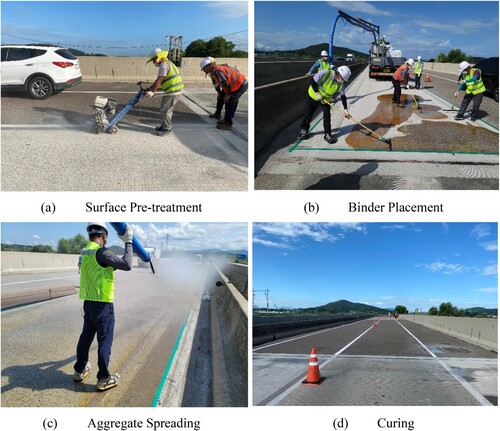
As in the laboratory test and initial experimental construction, the binder, which is a mixture of three parts of epoxy from either Company A or Company B and one part of the hardener, was manually applied onto the pre-treated existing pavement surface, as illustrated in (b). Fine aggregates – either from bauxite or flint rock – were subsequently dispersed onto the epoxy binder using specialised equipment. Traffic was permitted on the thin epoxy overlay pavement four hours after the completion of construction.
4.2. Results of bond strength test
In the laboratory and first field tests conducted on an existing slab in good condition, the CSP had a minimal impact on the bond strength. However, in the second field test, performed on a significantly deteriorated bridge deck pavement, a substantial variation in the bond strength was observed according to the pre-treatment method, as depicted in .
In the bond strength test conducted 2 days post-experimental construction, most of the destruction was evident in the existing slab, as illustrated in (a). The untreated section and the section pre-treated by shot blasting exhibited a bond strength below 1.7 MPa, consistent with the criterion suggested by the ACI. This subpar bond strength is attributed to the inadequate removal of the deteriorated surface from the existing pavement. Conversely, sections pre-treated solely by grinding and shot blasting followed by grinding satisfied this criterion. The section pre-treated with shot blasting followed by grinding exhibited the highest bond strength.
Figure 17. Depth of Destruction According to Age of Overlay. (a) 2 Days after Overlay; (b) 2 Months after Overlay.
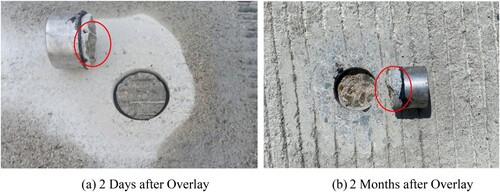
All sections, whether untreated, pre-treated by shot blasting only, or grinding, shared similar surface conditions equivalent to those of CSP 3. However, they demonstrated a significant variation in the bond strength, as depicted in . Thus, the degree of removal of the deteriorated pavement surface influenced the bond strength more than the visually assessed condition of the existing pavement surface immediately after the pre-treatment.
All sections exhibited a bond strength of over 1.7 MPa regardless of the pre-treatment method 2 months after the experimental construction, as illustrated in . Notably, the bond strengths of the untreated sections and those pre-treated solely by shot blasting, where the initial bond strengths were relatively low owing to the insufficient removal of the deteriorated parts of the existing pavement surface, significantly increased.
The bond strength increased because the epoxy binder penetrated deeper into the existing pavement's deteriorated surface over time and hardened. Therefore, 2 days after the experimental construction, destruction occurred in the existing pavement at a relatively shallow depth of approximately 10 mm or less because the epoxy binder penetrated the deteriorated pavement surface and hardened to a shallow depth, as illustrated in (a). Conversely, destruction occurred at much deeper depths of approximately 20–30 mm over 2 months post-experimental construction, as demonstrated in (b), because the epoxy binder extended and hardened to a greater depth over time. Thus, to ensure superior performance, the deteriorated parts of the existing pavement should be sufficiently removed before constructing a thin epoxy overlay.
5. Conclusions
In this study, the factors influencing the bond strength between thin epoxy overlay and existing pavement were investigated via laboratory and field tests. The main conclusions of this study are as follows.
The bond strengths of specimens fabricated by applying an epoxy binder and distributing fine aggregates over the LMC were tested in a laboratory setting. Consequently, the maximum bond strength was recorded at 25 °C and 60% relative humidity. The bond strengths of the specimens cured under completely wet conditions, similar to those cured at high temperatures of 40 °C, did not satisfy the criterion proposed by ACI. Hence, strict temperature and humidity management are crucial when constructing thin epoxy overlay pavements.
In the first field test, a thin epoxy overlay was applied to a well-maintained concrete pavement, followed by tests conducted 3 days, 6 months, and 1 year post-construction. The bond strength, measured 3 days after construction, experienced a significant decrease at the 6-month mark, after which it remained consistent for up to a year. Low temperatures during the initial winter affected early bond strength. The bond strength, measured 6 months post-overlay, significantly decreased owing to repetitive vehicle loading. Furthermore, the bond strength, which varied immediately before vehicular loading, exhibited consistent values immediately after loading.
The results of the laboratory and first field tests revealed that irrespective of the pre-treatment method, the bond strength remained relatively high when the existing pavement surface was in good condition. In most tests, debonding was not observed at the bonded interface between the overlay and the existing pavement; instead, the existing pavement experienced damage, thus suggesting that the actual bond strength between the epoxy binder and pre-existing pavement surface was likely higher than the measured bond strength. Consequently, when the existing pavement is in good condition and the bond strength of the epoxy binder is excellent, the CSP of the existing pavement resulting from the pre-treatment does not influence the bond strength.
The second experiment was conducted on deteriorated bridge deck pavement. The bond strengths of the sections where the degraded pavement surface was inadequately removed proved relatively low 2 days after the experimental construction. The destruction occurred at shallow depths in the existing pavement 2 days post-construction, whereas, after 2 months, it occurred at greater depths, attributed to the epoxy binder penetrating the existing pavement surface and solidifying at deeper levels over time. Thus, the deteriorated sections of the existing pavement should be thoroughly removed before constructing a thin epoxy overlay to ensure superior performance.
The changes in the bond strength and performance of the thin epoxy overlay pavement will be investigated over long periods. In addition, the effect of the pre-treatment method on pavement performance will be investigated. A structural analysis will also be performed to verify the effect of eliminating existing deteriorated pavement surfaces on the bond strength.
Acknowledgement
This study was conducted under the research project ‘A study on the quality performance standards and field applicability of materials for constructing the thin-layer pavement method’ funded by Korea Expressway Corporation (KEC).
Disclosure statement
No potential conflict of interest was reported by the author(s).
Additional information
Funding
References
- American Association of State Highway and Transportation Official (AASHTO), 1995. Guide Specification for Polymer Concrete Bridge Deck Overlays, AASHTO Task Force 34, USA.
- American Concrete Institute 546.3R (ACI), 2014. Guide to Materials Selection for Concrete Repair, ACI 546.3R, USA.
- American Concrete Institute 548.5R (ACI), 2016. Guide for Polymer Concrete Overlays, ACI-548.5R, USA.
- American Concrete Institute 548.5R (ACI), 2019. Specification for Type EM (Epoxy Multi-Layer) Polymer Overlay for Bridge and Parking Garage Decks, ACI-548.8-19, USA.
- American Society for Testing and Materials (ASTM), 2018. Standard Specification for Epoxy-Resin-Base Bonding Systems for Concrete, ASTM C881/C881M, PA, USA.
- Choi, M G. et al, 2021. Laboratory tests on skid resistance and bond strength of thin Epoxy polymer concrete overlays. International Journal of Highway Engineering, 23 (3), 25–32.
- International Concrete Repair Institute (ICRI), 2013. Technical Guidelines Selecting Specifying Concrete Surface Preparation for Sealers, Coatings, Polymer Overlays, and Concrete Repair, Guideline No. 310.2R-2013, IL, USA.
- Justin, D., and Brent, P, 2016. Polymer concrete overlay evaluation, InTrans project 13-463, SPR RB34-012, Institute for Transportation, Iowa State University, IA, USA.
- Kim, H. J., et al., 2013. The physical properties of polymer concrete for ultra thin bridge deck pavement. Journal of the Korea Institute for Structural Maintenance and Inspection, 17 (3), 74–81.
- Kim, J. H., 2014. Evaluation of Engineering Properties and Performance of Epoxy Mixture for Thin Bridge Deck Overlay. Ph.D. Dissertation, Hanyang University.
- Kim, M. J., et al., 2016. Vibration properties of concrete overlays using RS-LMC. Journal of the Korea Concrete Institute, 28 (5), 571–579.
- Kim, J. H., et al., 2019. Study on improvement of porous pavement performance through site-construction Test. Korea Expressway Corporation.
- Lee S. W., et al., 2006. Bridge deck pavement using latex modified concrete. Magazine of the Korea Concrete Institute, 18 (3), 33–37.
- Ministry of Land, Infrastructure and Transport (MOLIT), 2019. Status and challenges of road maintenance - A study on road asset management.
- Réquilé, S., et al., 2019. Interfacial properties of hemp fiber/epoxy system measured by microdroplet test: effect of relative humidity. Composites Science and Technology, 181, 107694.
- Sun, Z., 2004. Evaluation of concrete bridge deck overlays, M.S. Thesis, West Virginia University, USA.

